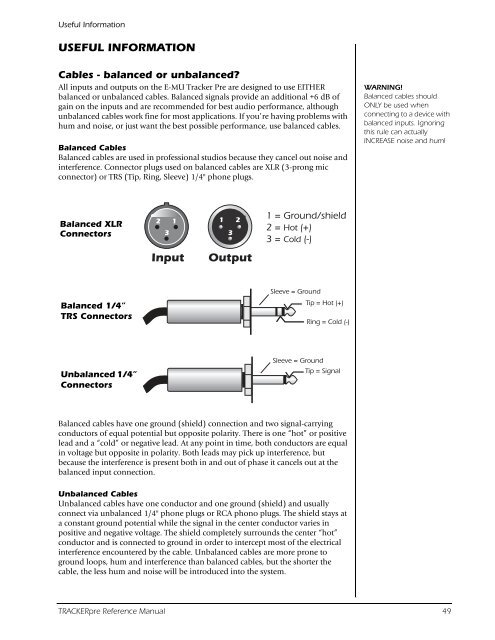Audio Interface / Mobile Preamp - zZounds.com
Audio Interface / Mobile Preamp - zZounds.com
Audio Interface / Mobile Preamp - zZounds.com
Create successful ePaper yourself
Turn your PDF publications into a flip-book with our unique Google optimized e-Paper software.
Useful Information<br />
USEFUL INFORMATION<br />
Cables - balanced or unbalanced?<br />
All inputs and outputs on the E-MU Tracker Pre are designed to use EITHER<br />
balanced or unbalanced cables. Balanced signals provide an additional +6 dB of<br />
gain on the inputs and are re<strong>com</strong>mended for best audio performance, although<br />
unbalanced cables work fine for most applications. If you’re having problems with<br />
hum and noise, or just want the best possible performance, use balanced cables.<br />
Balanced Cables<br />
Balanced cables are used in professional studios because they cancel out noise and<br />
interference. Connector plugs used on balanced cables are XLR (3-prong mic<br />
connector) or TRS (Tip, Ring, Sleeve) 1/4" phone plugs.<br />
Balanced XLR<br />
Connectors<br />
Balanced 1/4”<br />
TRS Connectors<br />
Unbalanced 1/4”<br />
Connectors<br />
Balanced cables have one ground (shield) connection and two signal-carrying<br />
conductors of equal potential but opposite polarity. There is one “hot” or positive<br />
lead and a “cold” or negative lead. At any point in time, both conductors are equal<br />
in voltage but opposite in polarity. Both leads may pick up interference, but<br />
because the interference is present both in and out of phase it cancels out at the<br />
balanced input connection.<br />
Unbalanced Cables<br />
Unbalanced cables have one conductor and one ground (shield) and usually<br />
connect via unbalanced 1/4" phone plugs or RCA phono plugs. The shield stays at<br />
a constant ground potential while the signal in the center conductor varies in<br />
positive and negative voltage. The shield <strong>com</strong>pletely surrounds the center “hot”<br />
conductor and is connected to ground in order to intercept most of the electrical<br />
interference encountered by the cable. Unbalanced cables are more prone to<br />
ground loops, hum and interference than balanced cables, but the shorter the<br />
cable, the less hum and noise will be introduced into the system.<br />
WARNING!<br />
Balanced cables should<br />
ONLY be used when<br />
connecting to a device with<br />
balanced inputs. Ignoring<br />
this rule can actually<br />
INCREASE noise and hum!<br />
TRACKERpre Reference Manual 49

















